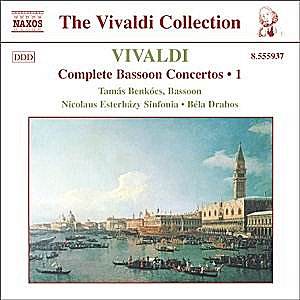Naxos's 'Vivaldi Collection'
flourishes. How many volumes will it
take up in the end? Now they tackle
the bassoon concertos. There are thirty-seven
of them in all so with seven on this
disc at least five discs will be needed.
It's not so much the cost but the shelf
space that may be the problem!
Each of these concertos
is, as you might expect, in three movements,
lasting between seven and a half and
nine and a half minutes. It has been
said that once you have heard one Vivaldi
concerto you have heard all 550. I suppose
that there used to be an element of
truth in this but recently we have been
treated to such superb performances
by, for example 'Arte dei Suonatori'
Baroque Orchestra under Rachel Podger
(the 'La Stravaganza' Violin concertos
on Channel Classics) and just recently
by 'Concerto Italiano' under Rinaldo
Alessandrini (on Opus 111) that the
old cliché begins to ring false.
The 'Red Priest' is indeed a fascinatingly
fecund composer whose music can be wildly
energetic or beautifully delicate and
poignant. Even so there were times on
this CD when yet another set of falling
sequences and repeated rhythms made
me ponder what to have for lunch, or
whether it would be more profitable
to hoover the car. Try the first movement
of the A minor concerto. When the attention
wanders you are sometimes rescued by
a beguiling melody or by a telling suspension
as in the middle movement of the G major
concerto.
Even Keith Anderson,
Naxos's regular and prolific annotator,
who is always informative and very helpful,
seems to be struggling to find useful
things to say. He is reduced to phrases
like "the solo passages are marked by
characteristic figuration, and a use
of the full range of the solo instrument".
Later the entry of the bassoon is "marked
by wide leaps and contrasts of register".
But then the two above-mentioned
recordings of Vivaldi are some of the
most vital and exciting performances
of his music ever committed to disc.
The Esterhazy Sinfonia can in no way
compete with them. But I'm not being
fair; I 'm not comparing like with like.
These, for one thing, are not playing
on original instruments. The Esterhazy
orchestra is also more conventional,
with a conductor at the head instead
of simply being led from the violin,
like Rachel Podger or from the harpsichord
like Christopher Hogwood.
Also, I'm not that
enamoured of the idea of positioning
all of the violins on the left-hand
speaker, the soloist in the middle of
the stereo picture and the continuo
to the right. Presumably this was the
idea of the conductor Bela Drahos although
engineer Janos Bohus must surely bear
part of the blame. The layout might
sound OK at first reading but
the many antiphonal passages written
into the music are lost, or not made
as much of as they should have been.
Examples of missed opportunities are
the finale of the F major concerto and
in the slow movement of the A minor
concerto.
The orchestral playing
is crisp and the dynamics are nicely
graded which is important in this music.
It is rather a pity that it often seems
that the orchestral work has been pushed
a little to the back of the stereo picture
making the bassoon slightly over-prominent.
The slow movements come off particularly
well with some beautifully poised string
tone.
I can only admire and
praise however Tamas Benkocs whose virtuosity,
lyrical tone across the all registers
and dexterity of finger-work is utterly
superb. He lifts the music and the recording
out of the ordinary into something approaching
the sublime.
The C minor concerto
is a real showcase. It begins with a
strong unison ritornello passage for
the strings. Then the bassoon comes
on and the movement takes off. It is
lithe, acrobatic and elegant. The upper
register is expressive. I can't help
but wonder what kind of player at the
'Ospidale de la Pieta' did Vivaldi have
in mind for this music. One of the pupils?
One concerto is dedicated to Giuseppe
Biancardi who apparently played the
dulcian, an early kind of bassoon. Incidentally
the slow movement for this concerto
is an editorial addition but, as is
quite typical at present, the editor
is sadly anonymous.
So to sum up. There
is much enjoyable music here. I suspect
that you probably need to be keen on
the bassoon or on unusual Vivaldi to
really appreciate it. However at Naxos's
budget price there is not much lost
if you only play it once.
Gary Higginson


